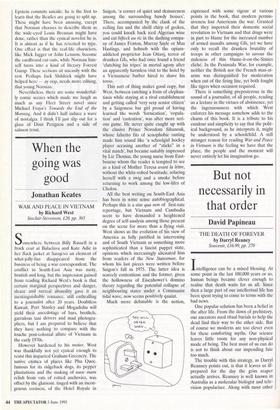But not necessarily in that order
David Papineau
THE DEATH OF FOREVER by Darryl Reaney Souvenir, £16.99, pp. 270 Intelligence can be a mixed blessing. At some point in the last 100,000 years or so, human beings became clever enough to realise that death waits for us all. Since then a large part of our intellectual life has been spent trying to come to terms with the bad news.
One popular solution has been a belief in the after life. From the dawn of prehistory, our ancestors used ritual burials to help the dead find their way to the other side. But of course we moderns are too clever even for these comforting myths. Our science leaves little room for any non-physical mode of being. The best most of us can do is not to think about our impending fate too much.
The trouble with this strategy, as Darryl Reanney points out, is that it leaves us ill- prepared for the day the grim reaper actually arrives. Reanney is well known in Australia as a molecular biologist and tele- vision populariser. Along with most other scientists, he takes it as read that the com- forts of traditional religion are no longer available to us. But he thinks we can do better than simply close our minds to the unwelcome truth. In his view, science got us into this mess, and so it can get us out again.
Reanney's cure for the human condition is to urge that the passage of time is an illusion. According to modern physics, he argues, time is simply another dimension, like the dimensions of space. We have the impression that we move through time from birth to death, but this is simply an artefact of the limited perspective of our `ego selves'. We need to transcend our per- sonal strivings, and recognise that past and future form an unchanging pattern in the cosmos.
This is certainly one way of understand- ing the world as described by modern physics. As Reanney acknowledges, it has affinities with those eastern religions which look for the permanent unity behind the world of desire and appearance. The diffi- culty with this kind of philosophy, however, is that it copes with death only by taking away the point of normal life. To those facing death it can be a consolation to know that time is an illusion, but it is not much help when you need to catch the 7.45 to get to work.
The dust jacket of The Death of Forever says that Reanney died of leukaemia short- ly after the book was published. The impression he creates is that of someone in a terrible hurry to find solutions. The book scurries from one aspect of science to another, searching for a way out of a cul- de-sac. It is awful luck to be cut short in the middle of a busy life. But by the end of the book I felt that Reanney was working on the assumption that nobody else has much time left either.
Along the way, Reanney makes a point that suggests a rather different view. He observes that some biological systems are perfectly capable of living forever. Old amoebae never die, for example, they just split in two. The only reason we more corn- • plex beings aren't similarly immortal is that evolutionary sums don't add up. There is no point in designing an everlasting body if there is a good chance it will eventually be eaten by a passing tiger. It would be like buying a Rolls Royce to enter a demolition derby. So evolution has given us throw- away bodies, and arranged for our descen- dants to carry on in our stead.
At first sight this might seem like unnecessary penny-pinching. But it is worth considering what it would be like to live forever. After a few thousand years it would be difficult to keep ennui at bay. The truth is that we are children of nature, and a finite span is essential to the meaning we find in life. Most of us, no doubt, will always be able to use a few extra years, but forever would be far too long. A ripe old age for those of us lucky enough to reach it would seem a sensible compromise.



































































 Previous page
Previous page